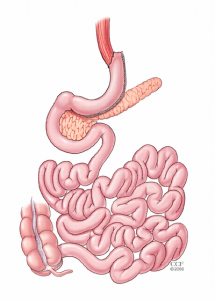Vertical Sleeve Gastrectomy

About the procedure:
In this procedure, the part of the stomach that easily streches to hold large meals is removed leaving an aproximately 1/2 inch wide by 8 – 10 inch long sleeve shaped stomach. The natural outlet of the stomach, the pylorus, is maintained to help pace the emptying of stomach contents. The section of stomach removed creates the hunger driving hormone ghrelin. Removing this section of stomach results in a marked decrease in ghrelin production and a lack of hunger. The lack of hunger usually lasts for 6 months to two years following surgery but the sensation of fullness after small meals lasts for a very long time. Vitamin, nutrient and medicine absorbtion are minimally changed and all medicines are well tolerated after Sleeve Gastrectomy.
How It Works:
1.) The small gastric pouch restricts meal volume, but more importantly, it allows early and prolonged satiety. Patients feel satisfied with a small amount of food, and they are not hungry or looking for food between meals.
2.) Removal of the remnant portion of the stomach minimalizes production of the hunger hormone ghrelin which markedly reduces hunger for a long time.
Indications:
The sleeve gastrectomy is indicated for use in weight reduction for severely obese patients with a Body Mass Index (BMI) of at least 40 or a BMI of at least 35 – 39 with one or more severe co-morbid conditions, or those who are 100 lbs. or more over their estimated ideal weight. A patient with a BMI of 40 usually weights about 100 lb above their ideal body weight.
Surgery may be considered for certain patients with BMI 30 – 35 although Insurance will not cover the cost of surgery if the BMI is less than 35.
Malabsorption:
A minimal decrease in the absorption of some nutrients has been suggested.
Vitamin Requirement:
Two daily multivitamins should be taken while a person is losing weight due to the decreased nutrient intake of dieting. Vitamin D as needed.
Dietary Restrictions:
Patients may experience dumping syndrome with intake of carbohydrate foods.
A condition known as “dumping syndrome” occurs as the result of rapid emptying of stomach contents into the small intestine. This is often triggered when too much sugar or large amounts of food are consumed. While generally not considered to be a serious risk to your health, the results can be extremely unpleasant and can include nausea, weakness, sweating, fainting, and on occasion, diarrhea after eating. Some patients are unable to eat sweets after surgery without experiencing dumping syndrome. A low carbohydrate diet enhances the effectiveness of this procedure.
Laparoscopic:
Yes
Number of incisions:
4 to 5 small incisions. Single incision surgery available to appropriate patients.
Intestinal Rerouting:
No
Cutting or stapling:
Yes – Stomach Wall
Hospital Stay:
Inpatient – Patients usually stay 1-2 night in the hospital
Recovery:
Most patients return to normal activity in two weeks.
Full surgical recovery occurs in two to three weeks.
Post Op Diet:
As with all surgical weight-loss programs, it is imperative that sleeve patients adhere to a strict postoperative diet. Patients must stick to a liquid protein diet for 3 weeks after surgery. Patients then graduate to a soft protein based diet for 2 weeks and then at 8 weeks, patients transition to a low carb solid diet. Once goal weight is achieved, usually 2-3 years after surgery, most patients consume a normal healthy diet with the appropriate number of calories for their height and build to maintain their weight.
Mortality:
The reported risk of mortality during the first 30 days following surgery for the sleeve gastrectomy is less than one out of 500 patients.
Hair Loss:
Patients may experience hair loss during the period of rapid weight loss, but hair growth usually normalizes with weight maintenance.
Bone Disease or Osteoporosis:
No increase in risk.
Iron Defiency Anemia:
No increase in risk.
Reversible?:
No. The sleeve gastrectomy is irrevirsible. Once the stomach is cut and the stomach remnant is removed it can never be restored.
Easily Adjustable:
No. The sleeve gastrectomy can only be adjusted through an additional surgical procedure.
Pregnancy:
It is not recommended that you become pregnant during the weight loss period following a sleeve gastrectomy due to inability to intake adequate nutrition. Weight loss after sleeve gastrectomy occurs because the patient cannot intake enough nutrition to support themselves, rendering them incapable of providing adequate nutrition to support a developing baby.
Contraindications:
The sleeve gastrectomy is not recommended for non-adult patients (will be evaluated on a case-by-case basis), patients with conditions that may make them poor surgical candidates or increase the risk of poor results, who are unwilling or unable to comply with the required dietary restrictions, or who currently are or may be pregnant.
Weight Loss:
Typical patients lose weight at a rate or 2-3 pounds per week. Weight loss is rapid but usually slows by twelve to eighteen months post op.
Patients that have a sleeve gastrectomy maintain on the average a total weight loss of 25% of their starting weight. Many do much better and some do not reach this level of weight loss.
